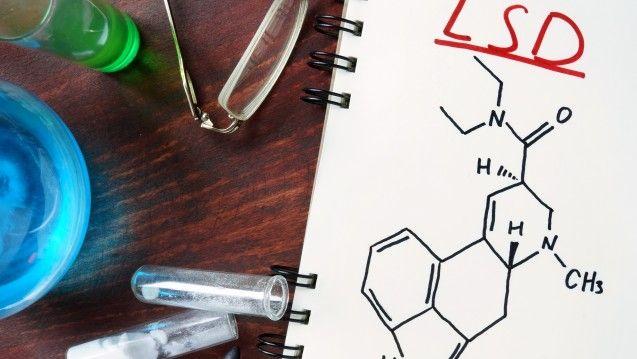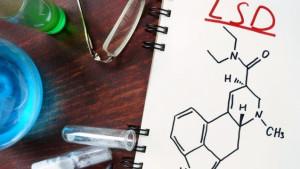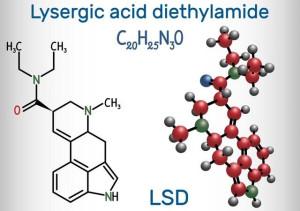
LSD

LSD is a semi-synthetic psychoactive substance from the tryptamine family. LSD can be considered the most famous psychedelic, used or used as a recreational drug, an entheogen, as well as as a tool in various transcendental practices such as meditation, psychonautics, or illegal (but legal in the past) psychedelic psychotherapy. LSD is synthesized from lysergic acid extracted from ergot, a microscopic fungus that parasitizes cereal plants (for example, wheat).
Pharmacological properties of LSD.
LSD is easily and completely absorbed by the gastrointestinal tract. Therefore, it is not necessary to inject LSD, except in special cases. Experiments on mice with radioactively labeled LSD have established that intravenously injected LSD disappears very quickly, leaving small traces, from the circulatory system and spreads throughout the body. Oddly enough, it concentrates least of all in the brain. Here it is concentrated in certain centers of the midbrain, which play the role of emotion regulators. These discoveries provide indications about the localization of certain physical functions in the brain. The concentration of LSD in various organs reaches maximum values in 10-15 minutes after injection, then gradually decreases. The small intestine, where the concentration reaches a maximum after two hours, is an exception. LSD is mostly excreted (up to about 80 percent) through the intestines through the liver and bile. Only from 1 to 10 percent of the processed products is unchanged LSD; the remainder consists of various decomposition products.
Since the psychic effects of LSD continue even after the moment when it can no longer be detected in the body, we must conclude that it is not active as such, but rather it triggers a certain biochemical, neurophysiological and mental mechanism that causes a state of intoxication and continues in the absence of the active substance. LSD stimulates the centers of the sympathetic nervous system of the midbrain, which leads to dilation of the pupils, an increase in body temperature, and an increase in blood sugar levels. As already mentioned, LSD causes uterine contractions. A particularly interesting pharmacological property of LSD, discovered in England by J.H. Gaddam, is its serotonin blockade effect. Serotonin is a hormone-like substance present in various organs of warm-blooded animals. Concentrating in the midbrain, it plays an important role in the propagation of impulses of certain nerves and, consequently, in the biochemistry of mental functions. The psychic effects of LSD have been explained for some time by disturbances in the normal functioning of serotonin, which are caused by LSD. Nevertheless, it was soon shown that even some derivatives of LSD (compounds in which the chemical structure of LSD is slightly altered), which do not exhibit hallucinogenic properties, inhibit the effects of serotonin as much or even more than unchanged LSD. Therefore, the fact that LSD blocks serotonin is not sufficient to explain its hallucinogenic properties.

LSD also affects neurophysiological functions associated with dopamine, which, like serotonin, is a hormone-like substance naturally occurring in the body. Most brain centers susceptible to dopamine are activated by LSD, while others are suppressed by it.
We still do not know the biochemical mechanism by which LSD affects the psyche. However, studies of the interaction of LSD with brain regulators such as serotonin and dopamine are examples of how LSD can serve as a tool for brain research, to study the biochemical processes that underlie mental functions.
LSD is sensitive to the effects of oxygen, ultraviolet light and chlorine (if it is a solution), but in the dark, at low humidity and low temperature can be stored for many years. In its pure form, LSD has no color, smell and slightly bitter taste. A typical method of administration is performed orally, for example, using a small piece of paper (“stamps”) soaked in a solution of a substance, or a piece of sugar, or for example in the form of gelatin. In liquid form, LSD can be taken in the form of drops (hence the English expression “drop the acid” – literally “drop acid”), or administered by intramuscular or intravenous injection. The threshold dose for a person is from 20 to 30 micrograms.
After its discovery, LSD was supposed to be used in psychiatry for the treatment of various disorders and diseases of the psyche, such as schizophrenia. The initial results of medical use showed great potential, but subsequently the out-of-control use of LSD among young people became too large, which caused a political scandal and led to a complete ban of LSD, for any purpose, both medical and recreational, and also spiritual.
LSD is the newest and most important drug that came from the psychotropic subculture. Huxley conducted experiments with mescaline long before psychotropic substances became widespread on the market, but these experiments had a completely different framework than the widespread use of drugs today. Probably, the main exponent of the idea of creating a great society based on psychotropic drugs was Antonin Artaud, who conducted experiments with peyote in Mexico. – The difference between Huxley’s and Artaud’s experiments is that Huxley conducted experiments on the walls of his laboratory, under the control of which he himself carried out, and Artaud made them part of his life. – Thanks to the acquaintance with peyote, Artaud changed, but was it bad? Because of this change, Artaud was able to comprehend and understand the ideas and worldview of another level. He was able to move away from rationalism, not to use modern methods of organization, and even modern truths. Artaud found, going his own way, his own truth and his own structure of categories. They cut him off from the rest of the world.
Physiological reactions to taking LSD are very different and can manifest as: uterine contractions, hyperthermia, fever, increased blood sugar, goose bumps, arrhythmia, bruxism, sweating, mydriasis (severe pupil dilation), salivation, insomnia, paresthesia, emotional euphoria, hyperreflexia, trembling and synesthesia. Some users also report the effects of tissue insensitivity, weakness, trembling and nausea. One of the earliest studies in the 1960s examined the use of LSD as an analgesic (painkiller) for the treatment of chronic pain caused by cancer or serious injuries. Even for minor doses, smaller than conventional psychedelic, it was found that as an analgesic, LSD acts no less effectively than traditional opiates (for example, morphine), at the same time much longer (in some cases causing an analgesic effect that lasted for a week after the peak of LSD action). Researchers explained this phenomenon by the mechanism of reducing anxiety and anxiety after the action of LSD.
Some doctors in the United States illegally use LSD to treat cluster headaches, a rare but extremely intense pain syndrome. Although this phenomenon has not been studied in formal medicine, multiple cases confirm the ability of LSD and psilocybin to reduce cluster pain and even interrupt the cluster cycle, completely preventing future manifestations of the syndrome. Well-known medications also used to treat cluster pain include various ergolines, among other substances, which may explain the similar effect of LSD. In a 2006 study, 53 patients with cluster pain syndrome who used LSD and psilocybin were interviewed, and most of the respondents reported personal experience of the healing effect. It should be noted that this study used small doses of substances that do not cause any psychological effects, which directly indicates the possibility of using LSD and psilocybin as an effective drug for the treatment of cluster pain syndrome
The effects caused by LSD in the psyche (colloquially called “trip”) vary greatly among different people, and strongly depend on factors such as the previous psychedelic experience, the current internal state of the psyche, the current situation and the external environment, and also, importantly, the total dose of the substance. The effects also vary from trip to trip, and even differ during one trip. LSD trip can cause long-term emotional experiences that remain after the psychedelic experience, and for some users cause significant changes in the structure of personality and attitude to life in general.
The term “Set and Setting” is used (Eng. Set and Setting) – set characterizes the dependence of the effects of LSD trip on the general internal state of the psyche, and setting – on the physical and social environment in which the trip occurs. If the user of LSD is in an unfriendly environment and is not internally prepared for possible extremely powerful distortions of perception and thought processes, the effects of LSD are likely to be very unpleasant, unlike the situation when the user is in comfortable conditions, is set up for good, does not strain and is internally open to the perception of the unusual.
Individual psychological effects may consist in an enhanced perception of colors, breathing or floating surfaces of things and furnishings (walls, floor, ceiling) with iridescent, crawling patterns, extremely complex colorful moving patterns that occur behind closed eyes, a sense of a changed flow of time, perception of things or people’s faces changing shape, depersonalization (loss of a sense of one’s own I), and sometimes very intense and violent experiences, described as one’s own rebirth or the ordeal of death.

The effect of LSD:
The initial stage is characterized primarily by unpleasant subjective sensations. 15-20 minutes after taking LSD, there is a feeling of shyness, fatigue, internal agitation, often anxiety, dizziness and headache. There may be unpleasant pain in the heart, cold or trembling of the hands.
– At the same time, various vegetative disorders are observed – redness or paleness of the skin, a feeling of heat or cold, sweating, increased salivation and lacrimation, nausea.
– The pupils of the eyes dilate, speech loses its harmony, the pulse becomes rapid, breathing becomes slow. Violation of coordination of movements leads to an uncertain gait, uncertain taking of objects. – The duration of the initial stage depends on the dose and method of ingestion of LSD in the body. It usually happens from 40 minutes to 1.5 hours.
Mental disorders begin with changes in emotional mood and behavior, which depend on the mental makeup of people. Some have alertness, depressed mood, depression, while others have euphoria. – Gradually there is a distorted (relative to the usual) perception of the world.
– Visual hallucinations usually occur in the form of brightly colored colorful images or paintings. They are supplemented by auditory, olfactory and tactile hallucinations, which in turn cause certain visual illusions. The phenomena of synesthesia (mixing of perceptions) are frequent, when music is smelled, a sound of color is heard or a touch of smell is felt.
There is an illusion of a split personality: the affected person records the events happening to him and around him, but believes that all this does not apply to him. At the same time, orientation in space and time is lost, against the background of thinking and speech disorders, the mental abilities of the affected person usually weaken.
During the period of LSD action, the mood can repeatedly change from euphoria to depression and vice versa. Many begin to suffer from persecution mania, become distrustful and hostile, hypersensitive to any touch to them. Their aggressiveness especially increases towards the end of the LSD action, which lasts 5-8 hours.
The state of consciousness when taking LSD qualifies as deafness of various degrees. Memory suffers only with severe poisoning, so after returning, most can describe their feelings. In the final stage, which can last 16-18 hours (and sometimes 1.5-2 days), there is a gradual disappearance of somatic and vegetative disorders.
In recent years, the question of how to help a person who has fallen into a state of uncontrolled panic under the influence of LSD has been widely discussed. It is said that using tranquilizers, you can calm a person and bring him out of an unpleasant state, but you should be very careful, because drugs certainly react with tranquilizers.
– It is preferable in this situation to try to create an atmosphere of looseness and benevolence. Under no circumstances, except for a real uncontrolled panic, it is impossible to place a person who has taken LSD in a city hospital.
– You should talk to a person, convince him that he is under the influence of acid and try to calm him down. Only a change of situation can effectively affect a person who has taken LSD unsuccessfully.
No cumulative effect was found in LSD, although long periods of psychosis were observed after repeated poisoning with small doses. Addiction to LSD was not noted.
